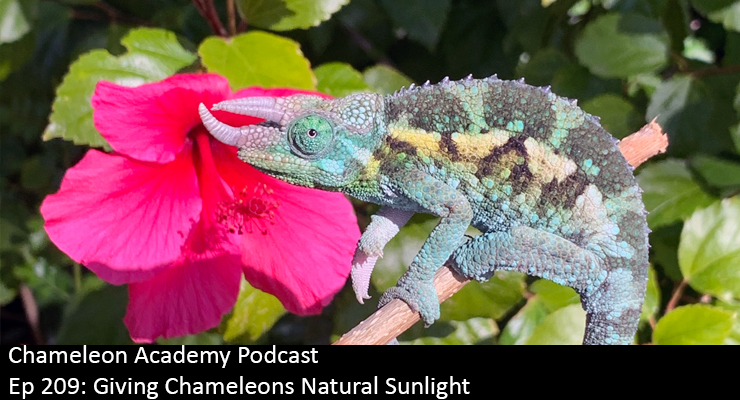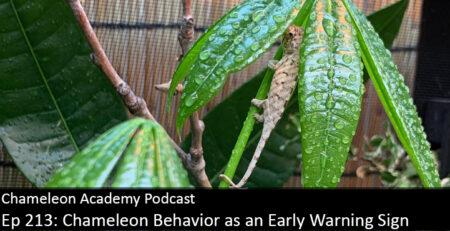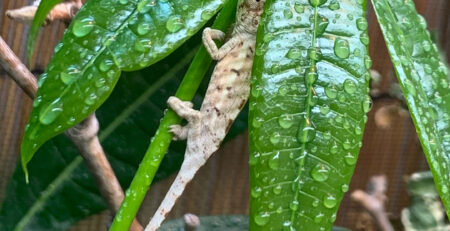Ep 209: Giving Chameleons Natural Sunlight
Listen Here!
Summer is approaching and it is time to take advantage of natural sunlight for your chameleons. Today we will talk about take your chameleon outside safely.
Link Resources
The following links were mentioned on today’s podcast:
Ep 16: Outdoor Chameleon Caging
Transcript (more or less)
We talk a lot about getting your chameleons outdoors for natural sunlight and breezes. And, for good reason. Chameleons thrive outside. Of course, it needs to be done right or else this could be a very bad thing for your chameleon. Back in 2016, which was the previous decade, I did an episode on outdoor caging where I went over types of cages and techniques. It was a meaty episode and the information is still good today. But I feel it is time to revisit the topic and add in some answers to questions that how popped up since. Considering the season, this is an especially good time to do it!
There is something different about being outdoors. We can feel it. Chameleons respond to it as well. One of the foundational skills in our art of chameleon herpetoculture is the creation of a healthy, vibrant environment within our homes. It is not an easy task! The better we are at what we do the better our environments replicate what is found in nature. We have come far, but we have far to go. I don’t think anyone disputes the benefits of exposing our chameleons to natural, unfiltered sunlight. Though that comes with caveats to make sure the chameleons do not die from a simple day in the backyard. Yes, on that downer of a sentence we have to be aware of just how dangerous the sun is if we do it wrong. So, let’s not do it wrong!
Before we haul our cage outside and give our chameleon some natural sunlight goodness lets go over some concepts.
First, Indoors keeping vs outdoors keeping. Nature is a wildly diverse number of conditions with a myriad of microclimates for an animal to choose from. Even in a desert, animals take shelter underground and inside cacti. If you took a weather station in Las Vegas, Nevada and replicated those weather patterns in a cage you would kill any animal that has thrived in that area for longer than humans have gambled. This is why captive husbandry is so challenging for us to figure out. We are having to determine what the ideal conditions are for an animal that spends its day moving amongst microclimates. In the chameleon world the difference between indoor and outdoor keeping can be seen in the Jackson’s Chameleon. Care sheets talk about cool temperatures and a deep night time drop. But whenever those parameters are mentioned there inevitably will pop up some person saying it is all ridiculous because Jackson’s Chameleons live in Hawaii where you don’t get those conditions. And then we have to explain that 1) Jackson’s Chameleons do not live at the weather station, 2) the microclimates they can find are different than the weather station, and 3) outdoors is absolutely different from indoors keeping! This is the problem when people have data and don’t have the context. Here’s a simple example. Two days ago it hit over 100 degrees F at my house. Standing under the sun was very uncomfortable and I stood there only to do this test because of how much I sacrifice for my art. I then moved myself to a completed covered patio. So I had a concrete slab with a roof overhead. Great ventilation. But it felt stuffy and the heat went from burning to oppressive. And then I moved into the shade of a huge ash tree. And it turned into a wonderful summer day to enjoy the birds singing. It was still warm, but very comfortable. I noticed cool breezes and I just wanted to sit down and stay for the afternoon. What changed? I found a comfortable microclimate. The weather app data didn’t change, but I was able to choose a place that was much different from what the weather data was reading. And this example is a way to understand outdoor keeping. The closer we get to outdoor keeping the more advantages of microclimates we can use.
With indoor keeping we reduce choices dramatically. Our house filters out the highs and lows of the outdoor temperature swings and the limited cage space reduces the microclimates to one or two. This is why we insist on the ideal conditions for our caresheets. Because you are picking around two microclimates for your chameleon to live its day in. Don’t pick conditions on the edge of what they can tolerate because the ability to deal with conditions on the edge of their tolerance zone is much less when they are forced to live it every day.
So, what does this all have to do with bringing your chameleon outdoors? When we bring our chameleon outside we obviously have to limit their movement or else we will not have a chameleon any more. So we have to be very careful how we expose our chameleon to the natural sun. Taking my example of the 100+ degree day. If I put my chameleon out in the sun I would have an overheated and soon dead chameleon. If I put my chameleon under the patio I would have an uncomfortable chameleon unless I added on cooling by misting. If I put my chameleon under the shade of the Ash tree I would have a very happy chameleon. At least until the sun moved to a position where it shown directly under the tree and the shade disappeared. So, our outdoors strategy needs to have both a position and a time element to it.
Okay, enough of outdoor theory. Let’s talk practical application. We have two scenarios to get our chameleon some outdoor benefit. We have bringing their indoor cage outside temporarily and having a special cage constructed for outdoor use.
Having an outdoor cage built specifically for the purpose of outdoor time is far and away the ideal and well worth the cost and effort. Both for the health benefit of your chameleon and the enjoyment level for you. The bigger the cage the more benefit and the greater the enjoyment. Here are the basics.
The most important aspect of outdoor keeping is to have a soil base. Ideally, directly on the ground, but otherwise on a planter box. I have done both. I have built cages directly on the ground and I have build planter boxes specifically designed to allow me to use commercially available screen cages. One of the most useful designed I share all the time is one where I have a planter box on wheels that I place a standard 2x2x4’ tall screen cage on. It works very well to allow me to roll it in and out of the sun and shade as is appropriate for the season. And this is a perfect demonstration of how the bigger the cage the more I can let the chameleon take care of himself. I live in Southern California so I have the opportunity to keep chameleons outdoors most of the year and some species all of the year. If I am keeping a Jackson’s Chameleon in a 4’ x 4’ x 6’ heavily planted cage on the ground he can stay outside all year. I just have a sprinkler system on timer and put in food a three times a week. The temperature can swing from the upper 30s to the 100 degrees and he will be fine. Obviously, it I much more complicated than this. I have mostly clear skies during the day so there is usually the opportunity to bask even on cold days so this would not work as well in areas that have extended cold, cloudy spells. So, please don’t take what I am saying here as a recipe. It is meant to communicate concepts. The point is that with that large cage he has all the microclimates he needs to take care of himself.
The next step down is my planter box cage on wheels. I have a 2x2x4’ tall screen cage onto a planter box with 1’ deep of soil. This is all on wheels so I can move it around. This is a much smaller space and it has enough microclimate range that I can figure out the right place for it once a day. If it will be cold or into the upper 70s then the cage can be in full sun. There is enough foliage in that cage to offer protection from the sun. If the day will be between 80 and 90 then I place it so it is half sun and half shade. Over 90 degree and the cage is fully shaded. My favorite placements are where the cage gets morning sun and then shade during the afternoon. Sometimes I put one of those portable canopy tents up with the cages under that. The cages get morning sun and the afternoon sun is blocked.
One more step down is moving the indoor cage out for a little bit of time. This requires constant supervision to make sure the sun isn’t directly hitting the cage in a way that your chameleon is getting baked. There is a danger in the typical solid floor that screen cages come with. And that is that the sun will reflect off the floor an so the chameleon is getting sun from the top and sun from the bottom and you can see how there is zero gradient there and no way for your chameleon to escape the sun. That is why the soil floor is so useful for creating gradients. It acts like a heat sink. Keep in mind though, that your cage plants and system has been built around a relatively weak lighting system up top. The plants have grown to those light levels. If you put them out into direct sun, depending on the temperature, intensity of when you do it, and how long you do it, you could easily burn the leaves. Plant leaves grow to adjust to the light levels. You will notice that the more intense the light the smaller and lighter color the leaves are. The lower the light levels, the larger and darker the leaves are. This is in response to how much the leaf has to work to get enough light to feed itself. It is light being in a dark room and then suddenly the lights come on. Our eyes that have adjusted to the dark are blinded until we can adjust. Plants adjust by growing new leaves so the ones that are already grown will be burned by dramatic increases in light intensity. Ie…the sun.
If you do want to use your indoors cage outdoors for a couple hours, the best way to do this is to put the cage out in the morning when your chameleon is wanting to do the initial warm up. Let him do that with the natural sun. This is when he would be getting his main dose of UVB anyways.
Now, let’s talk UVB and D3. If your chameleon is getting natural sunlight, how should that change how you supplement him? It shouldn’t change anything. Your chameleon cage has a UVB light giving him the UVB he needs to synthesize D3. Replacing that with the sun is simply that – replacing it. So just supplement as you normally would. Of course, this assumes you are up with the times and offering sufficient UVB to your chameleon. If you have a husbandry routine that relies on vitamin D3 in the supplement then, yes, you don’t have to have D3 in the diet any more as your chameleon will synthesize it naturally. And I include this scenario just to be comprehensive. With the UVB technology we have today you don’t need to be relying on dietary D3. I don’t see any effort being spent further determining the required and safe dietary D3 levels when we can just use the natural UVB method that has its own shut off.
You will get some UVB in the shade, but it is greatly reduced. But that is okay. Chameleons do not need bright UVB all day. I know the caresheets all say keep the UVB on 12 hours a day and your favorite social media group will be highly agitated if you only give UVB a couple hours a day, but a morning warm up in direct sun is going to do the job of giving them their daily D3. This can also be a morning UVB basking inside the cage. So do not worry about the UVB levels under shade if you have your chameleon out when it is too hot for direct sunlight. Even with indirect sunlight there will be a little UVB and even with very low UVB, there is still benefit to the natural breezes.
A quick way many people use to get natural sunlight to their chameleon is to just take the chameleon out and put him in a garden tree or bush. The need for supervision here obviously jumps exponentially. It is not just the slowly moving sun and overheating that is the danger. Now we add in escape and predators.
Back in the 70s, a pet store owner in Hawaii imported about three dozen Jackson’s Chameleons and put them in his nicely planted back yard to recover. When he went to retrieve them he found they had disappeared. Fast forward to today where Jackson’s chameleons are firmly established on a number of the Hawaiian islands. Chameleons may move slow, but they move fast enough that you being distracted by that YouTube video is all it takes for them to have found new digs or hide themselves. Have you ever seen a chameleon when it wants to move? Yeah, not as slow as you think. And once they are gone, they are exceedingly difficult to find. Taking a flashlight out at night is a better bet than trying to find them during the day. But it is best to avoid the situation all together and keep an eye on your chameleon. Though, the easier it is to see your chameleon the less protection he has from the sun so you have to find the right balance.
The other new complication is predators. You standing guard is a pretty good deterrent against the standard neighborhood cats or your dogs. But scan the skies. There are certain falcons that would love to try a chameleon meal and it was heartbreaking listening to a community member describe how he helplessly watched a falcon take off with his chameleon. The chances of a bird taking your chameleon are pretty slim with you standing there, but increase as you put a chair out and catch up on what the Kardashians are doing these days. I often put chameleons out on a bush when I am trying a mating on neutral ground – meaning outside of either the male or female’s cage. And for them to feel comfortable and concentrate on each other I have to be physical away from them. This decreases how I am able to react to any bird of prey that notices a wildly colored head bobbing morsel. So I sit myself down on a chair near by and have a chink of branch or something that I can throw at a bird. Now, I am not thinking I am going to hit a bird. All I need to do is have something big enough that it spinning through the air will surprise or distract the bird from completing its dive. Will it work? Well, I haven’t had to use it yet so I am hoping the hypothesis is sound and it will be effective should I need it one day!
Another question that comes up is whether it is okay for your chameleon sunning itself to enjoy the occasion snack flying by. Concerns center around pesticides and stinging insects. I have not yet heard of a chameleon being negatively affected by pesticides from eating an insects or being stung by a bee or wasp. I, personally, have feed wild bugs for decades with no problem at all. The only reason why I do not make a blanket statement is because there will always be special considerations. If you live in a heavily agricultural area where there are great amount of pesticides you’ll have to make your own decision. I still don’t see a problem with feeding wild insects, but we are getting out of my realm of experience and expertise so I respectfully acknowledge my limitations in being able to give advice for extreme examples. With bees I have no problem. I used to be concerned, but my Jackson’s Chameleon who had climbed out of my reach just sat there ignoring my worried face while it sat and picked off bees like he was in a candy store. I often wonder how they would fare with a mud dauber wasp that has that multi-directional stinger. Is that a danger? I assume that if the chameleon got in the standard first bite it would be over, but if it missed the first bite would that split second give the mud dauber the chance to bring in the stinger? I don’t know the answer to that question and would welcome the experience of anyone who has been seen that. But, generally speaking, my perspective is that I encourage as much wild insect feeding as possible. The added diversity of diurnal, meaning daytime, insect prey is a valuable addition to my chameleons’ healthy diet.
So, there is an overview of getting some natural sun. The benefits are real and I would encourage you to offer it to your chameleon when the weather is good. And if you at all can swing it, have a large permanent outdoor cage for your chameleon to be in during the months of the year that are good enough weather for your particular chameleon species. I used to have both an indoor cage and an outdoor cage for each chameleon I kept. My collection has expanded a bit, but I am actively working on bringing it back down because the most enjoyable chameleon keeping time period was when I had that arrangement. Besides, it is so cool trying to find your chameleon in a huge cage. I would see them when they were basking and then they would be out of sight the rest of the day. There is something very satisfying about being able to see those natural behaviors.
Okay that is the talk for today and everyone is welcome to go on with their chameleon keeping lives. But if you feel like sticking around and going to the digital coffee shop on the other side of the Wi-Fi we can sit down, relax and shoot the breeze about current events.
Doot doot doot la la la humming and moving chair out pouring coffee
New ZooMed LED UVB
Well, have you seen the news about UVB LEDs? We have a couple of companies, including ZooMed that are talking about releasing UVB LED products. These are of particular interest as they would be a way of giving solid UVB with lower power consumption. Sounds like a good idea! The problem is that manufacturing a reliable UVB LED has been challenging. And it just doesn’t seem like the technology is ready for prime time. But suddenly we have these companies talking about real products that they will, presumably, mass produce. Okay then… I suppose we can give them the benefit of the doubt and let them show us what they can do!
ZooMed has announced a 9W LED bar that supposedly produces pretty strong UVB. This product is not available anywhere yet. So, all we know is that the marketing department has been hard at work. There is no indication as to what the engineering or manufacturing teams have been up to. So, let’s assume the marketing team has been fed the right information. This UVB intensity looks like it is supposed to rival their T5 High Output lights. So that is a pretty high bar. Obviously, I will buy one as soon as it hits the shelves. Everything we have heard so far about the technology is that it is not ready for prime time. So here are your possibilities. 1) ZooMed is trying to get attention by promising a product that won’t be ready for months or who knows how long. In my professional life I do Product Marketing so I know this strategy well and it drives me crazy. It is used for attention and to gauge market reaction. 2) ZooMed will release a product before it is ready and deal with the aftermath. I know this strategy as well and, yes, this drives me crazy too. There are always unpleasant things that come up in production, but I never support doing it on purpose. Or else 3) ZooMed got it done.
Now, this is in a mini LED bar format so you are going to screw it in to a horizontal A socket. ZooMed has a 12” and 18” Naturalistic Terrarium Hood product where the 12” holds one LED bar and the 18” hold two LED bars. This LED bar does have a combination of 6500K LEDs for white light and UVA&B LEDS for the UV light so it is trying to be an all in one solution.
Obviously, I’ll be able to talk more about it once I have it. But, first impression is that I am not sure at this point that we will be using this particular product much as chameleon people. It all depends on how much light really comes off this bulb. The spot light effect of the UVB means you will get intense UVB in a focused area of the cage. As chameleons can detect UVB and will seek it out to bask, this may work. But I don’t see the white light portion of the bulb being anywhere near what we need to light our cages. Most minimum cage sizes are 48” tall so we need some healthy light output. Our current LED bar offering, which is only white light, is the Arcadia Jungle Dawn LED bar. I have used this since it was released and have grown beautiful flowering vines in my chameleon cages. But the Jungle Dawns are 22” of densely pack LEDs so this UVB LED technology may or may not be useful to us as both UVB and white light. That said, UVB LED technology would, in subsequent form factors, be amazing if they do work so we should keep an eagle eye on this technology. Once they work out the bugs that go along with any new product I am confident we will see more form factors.
Obviously, I will report back as soon as I know more. And if any of you see it available, drop me an email to make sure I see it too!
Panther Story update
In other news, there has been a lot going on on the chameleonacademy.com website. I have updated the chameleon cage safe plant list with the report that the Hoya plant has been eaten by a veiled with no ill effects. For those who don’t know, I keep a Chameleon Safe Plant list and I have a special designation which is “Veiled Tested” by each plant that the community reports has been eaten by a veiled chameleon with no ill effects. Now, we do have to acknowledge our limitations. There are, I think, 900 species of Hoya. So we need to be realistic in how scientific this is. I have used carnosa, obovata, pubicalyx so that leaves just 897 species to go. But, it is far and away much better than just reprinting the safe plant lists for cat and dogs and relabeling them Chameleon safe plant lists. You can use the Chameleon Academy plant list and know that what is on here is a result of use with actual chameleons. You can access the new plant list by going to the URL chameleonacademy.com/plants.
I am also slowly and methodically building out the chapters in the panther chameleon story where I am documenting a breeding lifecycle of the panther chameleon. I say methodically because I am producing webpages, podcast episodes, and videos for each chapter. By the end you will have a complete multi-media chameleon husbandry guide. A lot of fun, but a lot of work. My approach is that I am going to keep two pairs and keep this breeding project small. Each adult breeder will be kept as a pet in a naturalistic cage and the babies raised as individually as possible. And I say “as possible” because another purpose of me documenting this project is that I want to show all the things that could go wrong and 1) how to plan for and head them off before they happen and 2) what to do when you find yourself in a bind with something you didn’t plan for! So you’ll get to see me planning for the babies all through incubation and then you’ll see me figuring things out on the fly as unexpected things come up! The most valuable thing about experience is knowing what to do when the unexpected happens. Panther chameleon breeding has become a recipe of sorts, but that means it is easy for people to get started and get in over their heads quickly. Hopefully, this series will flesh out keeper’s understanding of their panther chameleon and breeder’s ability to maintain the enjoyment in chameleons that inspired them to start breeding in the first place.
And, finally, I just want to say how much I love working with brightly lit cages. When I started this podcast back in 2015 it was still common for chameleon cages to be dark caves with a small lit area up top. Now, there are so many bright light options that we can use people are easily starting to put in passion flowers or mandevilla or other flowering vines that were usually considered outdoor flowers. And I, for one, love this trend. This is great for the chameleons as well because they are finally getting brightly lit cages. Sight is very important to them! Anyway, I am sure I’ll be talking more about that topic in some official podcast coming up, but for now I am just going to encourage you to get that quad bulb fluorescent fixture or that LED bar or both. I did a YouTube video on putting together a 2x2x4’ tall cage with a quad bulb T5 HO 6500K fixture. Don’t settle for the dual bulb fixture! Screen cages are a little difficult. Even with bright light up top they leak light like a sieve. I use white sided hybrid cages and I love how the light is kept in the cage. You can retrofit your screen cages to capture some of that glory by putting white coroplast or PVC sheeting on the sides of your screen cage and then you can retain your hard won light. Anyway, take a look at the Chameleon academy Instagram account and you’ll see picture of what the inside of cages could look like.
Okay, I thank you for hanging out with me here. It is time I go work on a video. I hope you have a great week and I’ll see you back here either in a week or two I am still working on that production schedule and my videos are still taking too long. But I am getting a little better! See you all next time!













